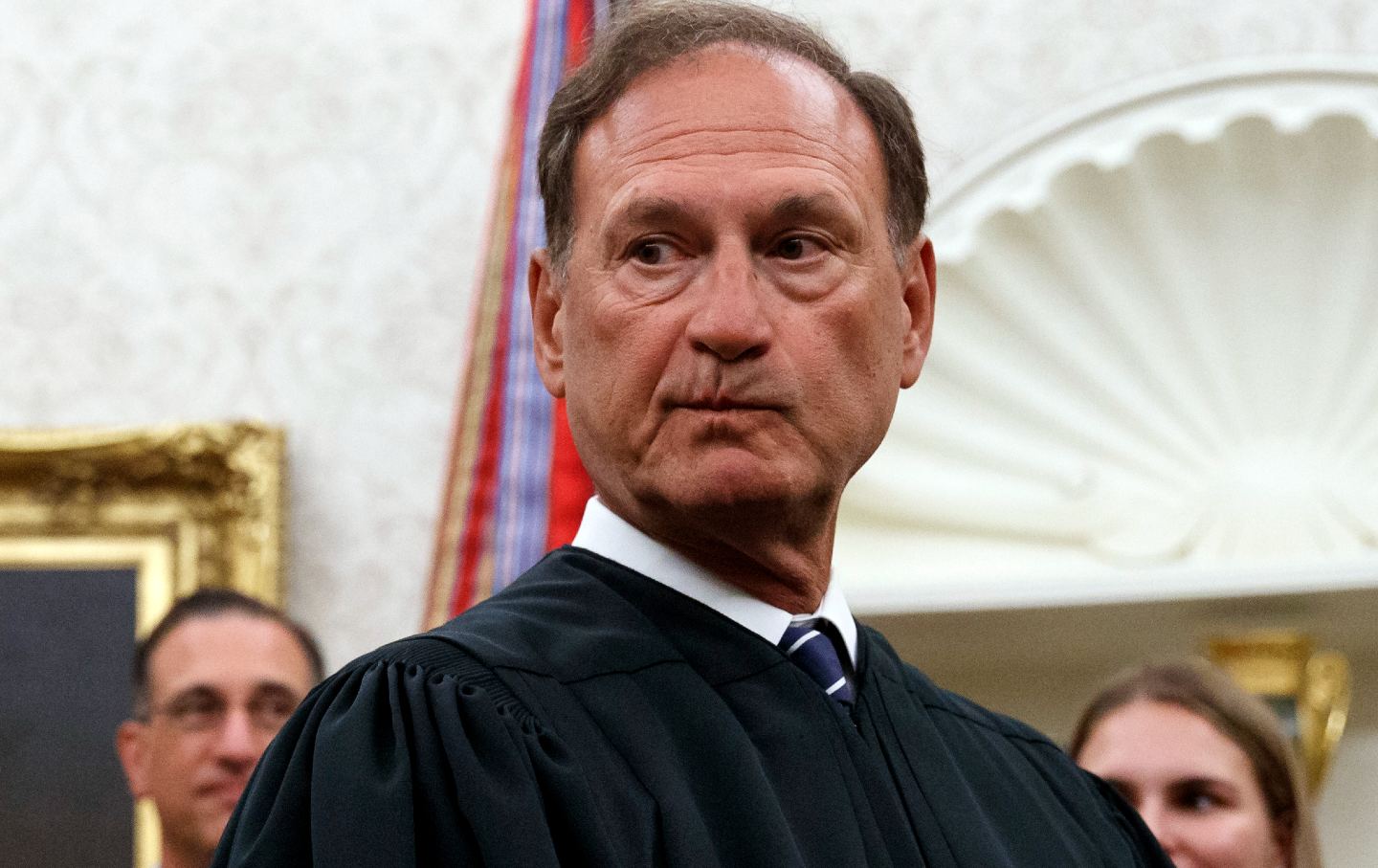Samuel Alito’s Opinions Are Just As Upside-Down as His Flag
In a majority opinion rubber-stamping South Carolina’s racist congressional map, Alito made it effectively impossible to contest racial gerrymanders.

Supreme Court Justice Samuel Alito
(Carolyn Kaster / AP Photo)On Thursday, MAGA’s chief justice and amateur vexillophile Samuel Alito once again used his unchecked power on the Supreme Court to help Republicans win elections. In so doing, he moved the country a little closer to his ultimate goal of reading the Reconstruction amendments right out of the Constitution.
He did this through a case called Alexander v. South Carolina State Conference of the NAACP. At issue was South Carolina’s racist congressional map—and more specifically, the way the South Carolina Republican legislature had redrawn the contours of the state’s District 1.
District 1 is currently represented by Republican Congresswoman Nancy Mace. It’s historically been a safe district for Republicans, but in 2018 a Democrat, Joe Cunningham took the seat with just 50.6 percent of the vote. (Twenty eighteen was a weird election, not just because it was the “blue wave” year, but also because the seat had previously belonged to Republican Mark Sanford, who was embroiled in a sex scandal.) In 2020, Nancy Mace narrowly defeated Cunningham to retake the seat for Republicans, but by the same razor thin margin. To avoid these kinds of close scrapes in the future, Republicans redrew the district after the 2020 census, and Mace won reelection with 56.4 percent of the vote in 2022.
The way South Carolina redrew the map, however, was racist. Republicans accomplished the goal of protecting Mace by systematically removing Black voters from her district. The new map splits the city of Charleston, South Carolina, in two, and takes most of the Black voters who live there out of District 1 and puts them in District 6 (which is currently represented by Representative Jim Clyburn and is the only one of the state’s seven districts currently held by a Democrat).
I’m not the only person who thinks removing a bunch of Black voters from a district to make it safer for a white Republican Congresswoman is racist and therefore unconstitutional. A three-judge district court panel in South Carolina ruled that District 1 was a racial gerrymander and ordered South Carolina to redraw its maps.
The South Carolina legislature refused, however, and appealed the district court’s ruling. That appeal was heard by the Supreme Court all the way back in October of 2023. It was literally one of the first cases the court heard in this term. But the court waited until yesterday, seven-and-a-half months after hearing oral arguments, to issue its ruling determining which maps South Carolina can use in the upcoming congressional election. That is significant because, while the Supreme Court was dragging its feet on this case, the South Carolina district court withdrew its order, saying that there was no longer enough time for the legislature to redraw the map even if the legislature lost its appeal. The Supreme Court locked in South Carolina’s racist gerrymander, simply by doing nothing.
Thursday’s opinion rubber-stamping South Carolina’s racism was therefore not really about South Carolina; it was about preventing future challenges to racist maps. Alito accomplished this by effectively making it impossible for Black people to prove that the 14th Amendment’s Equal Protection Clause has been violated when our voting rights are taken away through racist gerrymandering. He did this by ruling that state legislatures must be presumed to be acting in good faith; he then left nearly no avenue for people to challenge the racist handiwork of these legislatures.
It’s a wild presumption, given that the 14th Amendment and its Equal Protection Clause were written right after the Civil War, which was not exactly a time when the Northern victors believed in the “good faith” of their defeated Southern slaveholding cousins. If anything, the 14th Amendment was written to address the bad faith of the slaveholding states, which the Northern ones knew would try to deny equal rights to the newly freed citizens. But according to Alito, this critical revision to the Constitution does not apply unless state legislatures functionally admit that they’re being racist.
Alito didn’t actually contest the fact that the voters were removed because they were Black. Instead, he simply doesn’t care. Alito said that because race is highly correlated with voting behavior, trying to make a district more Republican means trying to make a district more white. Since making a district more Republican is constitutionally permissible, making a district as white as possible must also be permissible.
Alito was essentially using the fact that Black people tend to vote for Democrats as a justification for being racist and diluting the impact of the Black vote. If Black people voted for Republicans against their own interests, maybe they’d be allowed to stay in District 1, but since they generally don’t, it’s OK for Republicans to banish them when trying to make a happy, whites-only district.
Alito then set the bar to prove an actual violation of the Equal Protection Clause so high that no challenge to racism is likely to ever meet it. He says that the cases should not be merely “circumstantial,” which means that you cannot prove that Republicans were racist by pointing to the racially biased results of their actions. He says that you generally need “direct evidence” of racism, which basically translates to finding a Republican map-maker who says, “I’m finna do some racism, today!” Alito points out that direct evidence is sometimes available, and that is true, because Republican legislators are sometimes so bold with their racism that they literally spell it out. But that’s usually not the case. Not every Republican is out there like Nancy Mace with a can of spray paint.
In this case, the NAACP had the math on its side. (I explained here that District 1 was purposely drawn to keep out communities with Black Voter Adult Participation over 17 percent.) It had the testimony of four experts explaining how the district represented a clear case of racial gerrymandering. And, not for nothing, it had the ruling of the district court, which is supposed to be the “finder of fact” in our judicial system. But Alito brushed all of that evidence to the side as “circumstantial.” He said that the experts were wrong. He said that the district court made a “clear error” of fact. The NAACP did not have Mark Sanford on the phone to his Argentinian girlfriend saying we gotta get the Blacks out of District 1, so none of the evidence the NAACP did have mattered, according to Alito.
In dissent, Justice Elena Kagan (joined by justices Sonia Sotomayor and Ketanji Brown Jackson) hammered Alito over his disregard for the factual record. Kagan was incisive, so I’ll just quote her:
The majority picks and chooses evidence to its liking; ignores or minimizes less convenient proof; disdains the [district court’s] judgments about witness credibility; and makes a series of mistakes about expert opinions. The majority declares that it knows better than the District Court what happened in a South Carolina map-drawing room to produce District 1…. In the majority’s version, all the deference that should go to the court’s factual findings for the plaintiffs instead goes to the losing defendant, because it is presumed to act in good faith…. So the wrong side gets the benefit of the doubt[.]
Kagan also wrote that Alito used an “upside-down form of clear-error review.” I don’t know if that was an oblique reference to Alito’s flag controversies, but it makes life better to believe that it is.
To highlight how bad Alito is at his job as an appellate judge, even Justice Clarence Thomas wrote that Alito “exceeds the proper scope” of review. But don’t worry—Thomas did not suddenly remember that he’s one of the guys South Carolina doesn’t want voting in their white districts. Thomas remains the kind of brother Harriet Tubman would have left behind.
Instead, Thomas wrote a separate concurrence agreeing with the majority’s overall judgment because, hoo boy, according to Thomas, the 14th Amendment can never be used to stop a state from drawing a racist map, no matter how much evidence the NAACP brings to the table. Thomas literally wrote that the Fourteenth (and 15th) Amendment can’t be used to stop the states from racism, and then offered up the wackadoodle theory that only Congress can punish the states for racist electoral maps by decreasing the number of representatives those states are allowed to send to Congress. From there, Thomas went on to criticize the Supreme Court’s ruling in Brown v. Board of Education (which is not the first time he’s done that) and Baker v. Carr (which was the first case where the Supreme Court stopped a racist redistricting plan) as examples of judicial overreach that the court has never recovered from. He argued that any attempt to prevent racist gerrymanders is an extension of Brown’s and Baker’s flawed use of judicial power.
Popular
“swipe left below to view more authors”Swipe →Over on Bluesky, Adam Serwer summarized the court’s ruling accurately: “I hope people understand that what we are seeing is the systematic destruction of the civil war amendments by the Supreme Court, which are what made America [an] actual democracy and upon which all minority rights in the United States rely.” That is the irreducible point of the court’s ruling.
The 14th and 15th Amendments were written specifically to restrain the states, to stop them from disregarding the human, civil, and political rights of Black people. But the Republicans on the Supreme Court don’t like those amendments; they don’t want the states to be restrained. They want to go back to an antebellum vision of America, not necessarily one where Black people are re-enslaved (though it’s possible I’m being overly generous to Alito here), but certainly one where the political and social equality of Black people must give way to the will of whites.
That is why Alito flies the insurrectionist flag. That is why Thomas and his wife supported the coup. Their opinions in this case about gerrymandering perfectly reflect their opinions on elections generally: The votes of the white majority (and more specifically, the Republican majority within the white majority) are the only votes that are allowed to matter. Trump lost the election, but he won the white vote. Since these two men think only the white vote matters, it’s not antidemocratic, to them, to think that Trump should still be in charge.
According to Alito and Thomas—and, yes, the other Republicans on the Supreme Court—if Black people could just get with the program and vote for the candidates the whites want to win, there wouldn’t be a problem. But since most Black people refuse to accept the wisdom of white conservatives, whites have to gerrymander Black political power away, and that has to be constitutional. Otherwise, we unassimilated Negroes might fuck it up for everybody.
More from The Nation

Enough With the Bad Election Takes! Enough With the Bad Election Takes!
To properly diagnose what went wrong, we need to look at the actual number of votes cast.

No, Kamala Harris Staffers Did Not Run a “Flawless” Campaign No, Kamala Harris Staffers Did Not Run a “Flawless” Campaign
Democratic strategists are still patting themselves on the back for a catastrophic defeat.

The Courts, Trump, and Us: A Q&A With David Cole The Courts, Trump, and Us: A Q&A With David Cole
Last time, the courts were an essential checking force on the Trump administration. This time around, they may again provide a check—if we push.

Congresswoman Barbara Lee on Why Shirley Chisholm Was Right Congresswoman Barbara Lee on Why Shirley Chisholm Was Right
The California Democrat explains why, during her 25 years in Congress, it was important for her “to disrupt and dismantle and build something that’s equitable and just and right.”...




